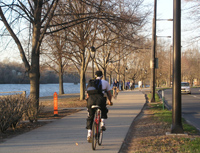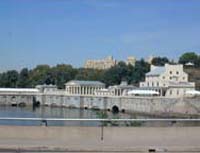Map Controls
- Reset the map
- View Trailheads
- View Trail Towns
- View Places to Visit
Map Legend
- Trailheads
- Trail Towns
- Places to Visit
- Schuylkill River Trail (SRT)
- On-Road SRT
- Proposed SRT
- Proposed On-Road SRT
Plan Your Trip
USING THE MAP
The Schuylkill River Greenways map is divided by Trailheads, Trail Towns and Places to Visit.
- Click on the category of your choice and a dropdown list of content will appear. Click any of the options within the dropdown menu and additional content will appear. Or, click on the “Places to Visit” category to see all available activities along the trail.
- Another way to navigate the map is to rollover the icons on the map. The preview will show you what kind of item it is. Click on it to reveal more information.
- Use the quick links at the top left to filter through Trailheads, Towns, and Places to Visit.
Trailheads/Parking
Trail Towns
Places to Visit
Fairmount Park


Fairmount Park was officially founded in 1855 when the Lemon Hill estate was dedicated as a public park and renamed Fairmount Park. Support came from 2,400 citizens who signed a petition urging the purchase of Lemon Hill.
Unlike New York City’s Central Park with its man-made landscapes, Fairmount Park evolved through the absorption of older estates, their tree groves and open meadowland without significant alterations.
Victorian park planners sought calming experiences and activities for park visitors. Compare this to today’s more athletic uses of the park. The park design attempted to discourage rowdiness by fostering reflection and access to healthy air and water. By the end of the 19th century, the Fairmount Park Commission began to accommodate the complex needs of the public, adding rather than limiting the scope of its recreation facilities and resources. The automobile, in particular, challenged the mission of the park as a place for quiet and recreation. On the other hand, it allowed greater access to the park, ushering in a new generation of park users.
Today Fairmount Park is comprised of 62 regional and neighborhood parks. The larger of these parks are: East and West Parks, Franklin D. Roosevelt Park, Pennypack Park, Poquessing Park, Tacony Creek Park and Wissahickon Valley Park.
Center, Franklin, Logan, Rittenhouse and Washington Squares are also part of Fairmount Park, as are the Benjamin Franklin Parkway, JFK Plaza (a.k.a. Love Park) and the Isaac D. Levy Park (Race and 17th Streets).
Fairmount Park is operated by the Philadelphia Parks & Recreation Department.
- National Historic Landmark
- Located in a historic district
- National Register of Historic Places